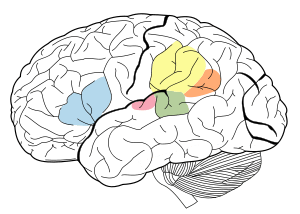Linguistics/Neurolinguistics
< Linguistics| Linguistics |
| 00. Introduction |
|---|
| Theoretical Linguistics |
| 01. Phonetics • 02. Phonology • 03. Morphology • 04. Syntax • 05. Semantics • 06. Pragmatics • 07. Discourse Analysis |
| Language as Signs |
| 08. Semiotics • 09. Sign Language • 10. Orthography |
| Language and the Human Mind |
| 11. Psycholinguistics • 12. Neurolinguistics • 13. Language Acquisition • 14. Evolutionary Linguistics |
| The Diversity of Language |
| 15. Typology • 16. Historical Linguistics • 17. Dialectology and Creoles • 18. Sociolinguistics • 18. Anthropological Linguistics |
| Appendices |
| Glossary • IPA Chart • Further reading • Bibliography • License |
Neurolingistics studies the relationship between language and the human brain. It branched off from psycholinguistics, which we've studied earlier. While this split occurred fairly late in the development of linguistics, the study of the relationship between language and the brain has been conducted since the 19th century.
Language Areas of the Brain

There are several areas of the brain of particular interest to neurolinguists:
- Broca's area/Anterior speech cortex: Named after Paul Broca, it is responsible for speech production.
- Wernicke's area/Posterior speech cortex: Named after Carl Wernicke, it is responsible for speech comprehension.
- Arcuate fasciculus: It connects Wernicke's and Broca's areas.
- Motor cortex: It controls the movement of our muscles. The part close to Broca's is responsible for moving the muscles that produce speech.
The localisation view states that our brain comprehends and produces speech in a definite pattern. After the word is input, it is decoded in Wernicke's area. Then the signal is sent through the arcuate fasciculus to Broca's area, where it is turned into speech instructions. These instructions are interpreted by the motor cortex, which then controls the muscles of our vocal tract.
Approaches to Neurolinguistics
Several approaches to neurolinguistics exist, in descending order of localisation:
- Localism: Rather than treating the brain as a whole, localism aims to find different centres of the brain responsible for different functions. These centres are either of equal status, or there may be one single centre that is more important than the rest. Language disorders result from deficiencies of these centres. Broca took this approach.
- Associationism/Connectionism: Language functions are dependent on connections between language areas. Linguistic ability is the ability to connect words and meanings, and language disorders result from the loss of this connection. Wernicke took this approach.
- Dynamic localisation of function: Subfunctions are still localised in different parts of the brain, but they must be combined together in a variety of ways to achieve greater functions.
- Evolution-based/Hierarchical: The brain has a layered structure, with lower strata dealing with more primitive language functions and higher strata dealing with more advanced ones.
- Holistic: The brain is treated as a whole, where many parts of the brain work together to interpret and produce language.
Language Disorders
There are two types of language disorders: acquired language disorders and developmental language disorders. Acquired language disorders result from brain damage, while developmental language disorders do not.
The study of aphasia, an acquired language disorder, is a central part of neurolinguistics. It is the loss of language ability due to brain damage. There are numerous types of aphasia, including the following:
- Broca's aphasia: Caused by damage to Broca's area, it results in declined speech production, though comprehension remains relatively normal. Agrammatic speech is a characteristic of Broca's aphasia.
- Wernicke's aphasia: Caused by damage to Wernicke's area, it results in reduced comprehension ability. People who suffer from Wernicke's aphasia can produce fluent speech, but their speech typically makes no sense. Anomia, a chronic version of the TOT phenomenon, is often observed in patients.
- Conduction aphasia: Caused by damage to the arcuate fasciulus, it results in relatively normal comprehension and speech but poor repetition. Paraphasia also occurs as they may pronounce sounds they do not intend to pronounce.
Other language disorders include:
- Dyslexia: It is a developmental disorder that results in a reduced ability to read.
- Dementia: It is an acquired disorder that results in, among other things, reduced language ability.
- Specific Language Impairment: It is a developmental disorder that results in reduced language ability with no obvious cause.